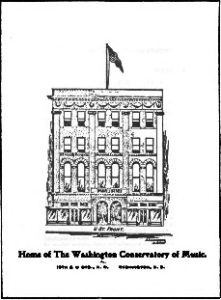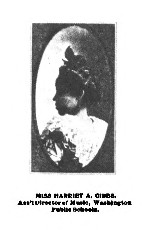As we continue down the rabbit hole of archival research—falling deeper toward CURI’s core—our process of burrowing into the lives and networks of early Washington Conservatory of Music graduates only gets hotter with the Summer. Still, it remains important to document what we did before diving into the archival databases. Specifically, we gained key background information on African American music from the early twentieth century, as well as on the history of mapping (both through this project and beyond), through several readings. In turn, we developed better contextual understanding of our work’s significance. By studying secondary sources with themes relevant to our work—including the complex nature of mapping, the reconstruction of Florence Price’s biography through her time at the New England Conservatory, and the impact of Harriet Gibbs Marshall and the Washington Conservatory of Music (hereafter WCM) itself—I’ve gained greater understanding of the nuances of Black music history to apply to our own research. I anticipate this will aid my analysis of the lives of several WCM graduates, in addition to helping frame my recent findings on one of the institution’s alums from 1912—Jewel Jennifer.
Mapping Music History
In Dr. Epstein’s De-Segregating Sound presentation, he considered complications with the historical collection of black folk music, in which imagined geographies caused regional disparities in song assemblage. Maps can help expose gaps in music history, which is why they’re apt for our own work. We want to reveal detailed networks of music-making stemming from WCM’s graduates, since they were equipped with advanced musical training. However, we must prepare for a potential reality that their records and contributions may’ve been limited to an extent due to racial repression during Jim Crow, and we’ll need to acknowledge this double edged sword depending on our findings. Historical documentation on Black American musicians’ lives has downplayed their contributions; as previously considered, biases in geography can lead to spotty records, quelling complex demographic realities (like Black folk music’s true prevalence). Also, it’s necessary to consider that maps themselves can be distorted for political or related purposes and are not neutral purveyors of information. This is something critical I gleaned from reading sections of Mark Monmonier’s How to Lie With Maps. We’ll need to acknowledge such sources as we dive into map making throughout the summer. Although maps understandably distort—moving from 3D into 2D to better express reality—this can sometimes be stretched too far. For us too, how we represent our findings is everything, as our maps and results will be made public—just like this blog post.
Lessons from Florence Price
Douglas Shadle’s A Florence Price Mystery Solved acknowledges how although performances of Price’s compositions have received resurgent attention in recent years, biographical information on her life is limited. Nevertheless, a recent breakthrough discovery of her address as a student at New England Conservatory demonstrates important aspects of her experience at the institution. She lived away from the main student residence, and would’ve faced unique challenges at a school largely catered to white students. The fact that her address “illuminates how race, gender, and the built environment converged to shape Price’s student experience” reveals the importance of locating biographical information like addresses, family members, institutional records, occupations and more in our own archival and genealogical research on WCM graduates.1 Information like this can be revealing both geographically, demographically, and contextually, given the socio-political realities of the early twentieth century. Consequently, we believe that locating enriching detail on 31 former WCM students could greatly enhance our maps’ stories and ultimate impact. It’s crucial to acknowledge that—with our locating of information on Black conservatory alums in the early 20th century—we’re careful in how we approach the research process. The concept of musicologists “discovering” Black musicians and their work, regardless of their historical stature, is problematic and entrenches a view of their marginalized position. Rather, phrasing our work as “finding ways to recreate their networks and share their contributions with a contemporary American audience” is more respectful of the shoulders we stand on and mindful of our positionality.

Figure 1. Signature of Florence B. Price. 9 September 2016. https://commons.wikimedia.org/wiki/File:Florence_price_signature.png
Standing on Schmalenberger’s Shoulders

Figure 2. Home of the Washington Conservatory of Music. Accessed June 22, 2022. Public Domain, Google digitized. https://www.hathitrust.org/access_use#pd-google
Reading sections of Sarah Schmalenberger’s dissertation on the Washington Conservatory of Music helped me consider what it means to be excitingly analyzing aspects of the same institution—similar in some ways, albeit conducted through a different lens and research style. The Musical Geography Project in 2022 seeks to look beyond Schmalenberger’s main focus on Harriet Gibbs Marshall in 2004. In a way, we’re continuing her response to the scholarly problem/gap of ignoring historically marginalized musicians’ contributions—specifically black women—in favor of male artists or bigger “success stories” in the music industry. Framing the process of black women’s participation and contribution to classical music in that era through reading scholarship—starting with Harriet Gibbs Marshall (hereafter HGM) and extending beyond her into the networks of graduates from the WCM—will be crucial to assessing the conservatory’s impact. Ultimately, did the institution’s mission of racial uplift take root in society through alums? Or was the seeding of HGM’s ideas stifled, perhaps providing a model for black music education though not taking root immediately? We hope to identify the seeds and networks cultivated by the conservatory, considering the critical nature of HGM’s original efforts to construct a black music educational infrastructure. With that crucial context, we’ll aim to highlight a largely anonymous infrastructure through reconstructive biography and interactive maps. We also had the great fortune of meeting with Dr. Schmalenberger last Monday, which allows us to better acknowledge her future recommendations regarding research on the Washington Conservatory. And at the end of her dissertation, she left some Easter Eggs of sorts related to our own project; specifically, In Ch. 5: Conclusion of Schmalenberger’s dissertation, she speculates that:
If Marshall began her teaching career by building upon her experiences at Oberlin, than perhaps her students, in similar fashion, used their experiences at the Washington Conservatory to inform their own teaching careers…As yet, the many African Americans who taught music in public and normal schools have not been studied for their philosophies regarding curriculum or repertoire. They remain part of…the “anonymous infrastructures” of the history of black musical practice…If more activities of black female educators and local artists were documented and assessed…then perhaps the history of American musical practices might more readily acknowledge the role of women in forming a black concert music repertory.2
Between her dissertation and our own research, we’re readily engaging with and seeking out the “anonymous infrastructures” described by her mentor Doris McGinty through our plunge into historical newspaper databases, genealogical records, and more.3 This can be challenging at times, as it’s essentially uncharted territory, though the possibilities and promise of our work have catalyzed the process. Nevertheless, with 31 graduates to research, I’ve already learned some intriguing facts about the lives and musical journeys of several WCM graduates in just my first three weeks of CURI. For Part II, click here.

Figure 3. Miss Harriet A. Gibbs (Marshall). Accessed June 22, 2022. Public Domain, Google digitized. https://www.hathitrust.org/access_use#pd-google
1 Douglas W. Shadle, “A Florence Price mystery solved (part one),” OUPblog (blog), May 10, 2022, https://blog.oup.com/2022/05/a-florence-price-mystery-solved-part-one/.
You must be logged in to post a comment.